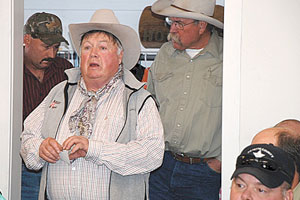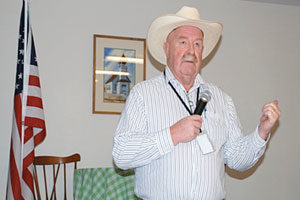According to Grey, the trend has reached each corner of the beef industry. He said cattle rustlers are looking to turn cows into cash as quickly as possible.
In Western states, a culprit is more likely to be stealing calves and raising them up, branding them and selling them later.
A group of 200 producers in western Idaho met in April to talk about prevention and to hear Idaho State Brand Inspector Larry Hayhurst describe how over 2,000 range and dairy cattle have been taken in the same region since the end of 2009.
“It goes like this,” Hayhurst said. “A cow is stolen that is branded. They take the cow out of state or simply hide the cow and each year you get a calf from her.
When a calf is born, you brand the calf with your brand and then market the calf when it is time. They also brand the stolen cow with a new brand.
“After a couple of years they simply mix that cow in with legitimate livestock going to slaughter in another state and chances are they are home free.
There are many ways to beat the system, but we’re more savvy than we used to be and know some important things we didn’t know a few years ago, including what to watch for.”
 Tom Blessinger, a producer from the Ola-Sweet area of Idaho, said locals are following prevention ideas from neighboring states, including hiring detectives, gathering and posting rewards, and setting up check-stations with local sheriffs and Forest Service personnel.
Tom Blessinger, a producer from the Ola-Sweet area of Idaho, said locals are following prevention ideas from neighboring states, including hiring detectives, gathering and posting rewards, and setting up check-stations with local sheriffs and Forest Service personnel.
Grey said the only way to combat the trend is through “vigilance, law enforcement/investigation and good convictions.”
The efforts in Texas are tough, however; that state is not a mandatory branding state, as only 52 percent of all cattle are branded.
Fred Fredrickson with the North Dakota Stock Association said he’s on the road “almost incessantly” to handle rustling issues.
He says there are only three inspectors in North Dakota, and they do everything from court appearances, to riding the range to check on cattle, to listening to people who have lost cows, to working with all state law enforcement to educate and inform.
“Around here these guys show up at night or when cattle are out grazing for three to four months and wait for a newborn to drop, then throw a lasso over a fence, pull the calf over and take it from under the fence,”
Fredrickson said. “They don’t even bother to take them across state lines. They just go home, make a few calls to sell or raise them up, brand them and sell them.”
He added that law enforcement struggles to get enough information for each case and that “lawyers and judges still think cows are worth $100 and rustling stopped in the early 1900s.”
Marty Clark of the Montana Department of Livestock said his state hasn’t realized a lot of loss so far this year or last year, but officials are worried “about what the headcount numbers will be when they come in after the summer grazing season.”
Clark said wolf depredation has added to the issue in his area. “We are also wondering if rustlers aren’t smart enough to be going in where there is a lot of wolf activity so losses will be pinned on the wolves and nobody will be looking for other predators.”
Rick Walhert, Colorado State Brand Inspections chief law enforcement officer, reports his state has seen all manner of ways and means to steal cattle, including white-collar crimes where one rancher leased his brand to someone who got a loan with it to buy cattle and then took the money, left the cattle and the country.
“There are rumors of drug money involved in fraudulent sales, lifting cattle across state lines, but I’ve been training state patrol officers and they are now doing roadside checks and staying vigilant for anything suspicious,” Walhert said.
Colorado’s losses haven’t reached levels seen in Texas, the Dakotas, Idaho, Oregon and Nevada, but Walhert agrees that the combination of a hike in prices, a sour economy and becoming lax in being observant and aware is taking a toll.
What to do – whom to call
If cattle rustling starts to emerge in your area, use the following offices:
• Local law enforcement and sheriff’s office
• Homeland Security
• Local fish and game office
• U.S. Bureau of Land Management
• State brand inspector’s office
You could also get the state brand inspector’s office observation notice booklet and post notices where you think people need to see them.
Pay attention to parties who are lingering where they should not be on somebody’s property. ![]()
Kathleen McKevitt may be reached at onelight.mckevitt3@gmail.com
PHOTOS
TOP: Larry Hayhurst, head of the Idaho State Police Brand Office, suggests rustling prevention methods to a group of Idaho producers.
BOTTOM: Tom Blessinger, owner of three ranches in western Idaho, speaks to a group of organized cattle producers on April 1 as a response to increased rustling. Photos by Kathleen McKevitt.







